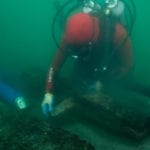 Weird Stuff
Weird Stuff  Weird Stuff
Weird Stuff  Health
Health Ten Confounding New Inventions from the World of Biomedicine
 Creepy
Creepy 10 Death Superstitions That Will Give You the Creeps
 Movies and TV
Movies and TV 10 Movies That Get Elite Jobs Right, According to Experts
 Weird Stuff
Weird Stuff 10 Times Real Laws Were Based on Bizarre Hypotheticals
 Animals
Animals 10 Inspiring Tales of Horses Being Human
 Mysteries
Mysteries Top 10 Haunting Facts About the Ghost Ship MV Alta
 History
History 10 Surprising Stories About the Texas Rangers
 Humans
Humans 10 Philosophers Who Were Driven Mad by Their Own Theories
 Miscellaneous
Miscellaneous 10 Video-Game-Worthy Weapons and Armors from History
 Weird Stuff
Weird Stuff 10 Warning Labels That Exist Because Someone Actually Tried It
 Health
Health Ten Confounding New Inventions from the World of Biomedicine
 Creepy
Creepy 10 Death Superstitions That Will Give You the Creeps
Who's Behind Listverse?

Jamie Frater
Head Editor
Jamie founded Listverse due to an insatiable desire to share fascinating, obscure, and bizarre facts. He has been a guest speaker on numerous national radio and television stations and is a five time published author.
More About Us Movies and TV
Movies and TV 10 Movies That Get Elite Jobs Right, According to Experts
 Weird Stuff
Weird Stuff 10 Times Real Laws Were Based on Bizarre Hypotheticals
 Animals
Animals 10 Inspiring Tales of Horses Being Human
 Mysteries
Mysteries Top 10 Haunting Facts About the Ghost Ship MV Alta
 History
History 10 Surprising Stories About the Texas Rangers
 Humans
Humans 10 Philosophers Who Were Driven Mad by Their Own Theories
 Miscellaneous
Miscellaneous 10 Video-Game-Worthy Weapons and Armors from History
10 Places with Fascinating Stories to Tell
Everyone loves a good story, whether factual or fictitious. This is why popular authors sell and why people love poring over history books. Earth itself has a fascinating history, and so do the 195 countries that dot our blue and white spinning globe. Inside these countries are several places with their own unique history and stories to tell, and they often serve as the location or inspiration for the tales people love so much.
Related: 10 Unexplained Mysteries Of The National Parks
10 The Town That Escaped the Tsunami
Fudai is a small village located in Iwate Prefecture, Japan, about 515 kilometers (320 miles) north of Toyko. In 1896 and 1933, hundreds of people died, and homes were destroyed in massive tsunamis that flattened the place in seconds. Late Fudai mayor, Kotaku Wamura, was in office for ten terms and wrote a book about Fudai in which he mentioned the 1933 tsunami, saying: “When I saw bodies being dug up from the piles of earth, I did not know what to say. I had no words.”
Wamura was determined, however, that his village would be protected against similar events in the future. He gave orders for a 15.5-meter (51-foot) seawall to be built in 1967. The wall was to protect homes behind the fishing port from large waves. Wamura went even further by putting a project in motion that saw a floodgate of the same height built for a cove up the road. This gate was to be built with panels that could be opened to allow for the Fudai River to empty into the cove but also close tightly to block tsunami waves. The gate was constructed between 1972 and 1984 at the cost of around $30 million and is flanked by mountains on either side. Residents initially balked at the idea and accused the mayor of wasting public funds.
On December 26, 2004, a massive tsunami wreaked havoc on the surrounding coasts of the Indian Ocean, killing 227,898 people in fourteen countries. In Fudai, the momentum of the tsunami was broken by the floodgates, and only minimal damage was caused by the 20-meter (66-foot) waves spilling over. However, one person was reported missing after he went to inspect his boat outside of the seawall just after the earthquake hit.
Soon after, villagers gathered at Kotaku Wamura’s grave to thank him for building the wall and floodgate and subsequently saving their lives and their village.[1]
9 Prague Orloj
Prague is the 13th largest city in the European Union and the capital of the Czech Republic. Here you will find stunning historical structures, including Prague Castle, Charles Bridge, and the Old Town Hall. Attached to the Old Town Hall is the medieval Prague Orloj or Prague astronomical clock, which was installed in 1410. Today it is the oldest working clock in the world and has three main components: an astronomical dial that represents the position of the sun and moon; statues depicting Vanity, Greed, Lust, and Death that become partially animated every hour; and medallions that represent the calendar months.
The clock also has a dark legend surrounding it. It claims the clockmaker, Mikuláš of Kadaň, had his eyes burned out by the city’s councilors because he had been approached by other nations who implored him to build them a clock equal in magnificence to the Prague clock. Being blind drove the clockmaker insane, and he threw himself into the mechanisms of the Prague Orloj, thereby cursing it. The curse would cause anyone who attempted to fix the broken clock to also go insane.[2]
8 Cerro Gordo
In 1865, Pablo Flores started mining silver from the hills overlooking Owens Valley in California. It wasn’t long before two local businessmen, Victor Beaudry and Mortimer Belshaw, heard about Flores’s venture and immediately began acquiring mining claims. By 1869 they had taken over the entire area, and it became the largest silver and lead producer in California.
Over the next 50 years, a town named Cerro Gordo sprung up at the site. The town housed 4,000 residents, seven saloons, and at least three brothels. At the height of activity in the town, there were many shootouts, murders, and accidents. At one point, there was one murder every week, and miners had to stack large sandbags around their beds to avoid being struck by stray bullets.
By 1938, however, natural water supplies were scarce, and mining activities had all but stopped because the silver, lead, and zinc resources were almost depleted. Residents had moved on to greener pastures, and Cerro Gordo officially became a ghost town.
In 2018, two friends, Brent Underwood, and Jon Bier, bought Cerro Gordo for $1.4 million, intending to restore it to its former glory. In 2020, Underwood drove to the town to relieve the resident caretaker, only to become stuck there after a massive snowstorm left him stranded. He ended up staying for 16 months and now chooses to live there while overseeing the rebuilding project. Underwood also believes the town to be haunted after witnessing lights coming on by themselves and books falling from shelves for no apparent reason.[3]
7 The Bleeding House

In 1986 a family moved into an ordinary house in Saint Quentin, located in the Aisne region of France. A month passed, and the family was just getting settled and used to their new surroundings when strange incidents started occurring inside the house. Low moans emanated from the ground level, and pots clanged when no one was in the kitchen. Believing it to be their neighbors just being noisy, the family carried on with their daily tasks.
Then, one day, the wife witnessed something that changed their lives. A red substance had started dripping down the kitchen walls. Her husband told her it was probably old paint coming through, but when the substance started appearing in other areas of the home, they contacted the police. After an investigation, the police determined that the substance was human blood.
The family decided to live elsewhere for at least a week and left a thick sprinkling of flour on the floor of the house in the hopes that they would catch someone playing a trick on them. When they returned, however, there was not a footprint to be found, but all the walls of the house were completely covered in thick blood.
The family sought the help of a local priest who inspected the bloody walls and told them that a demon was to blame and the house needed to be destroyed. The house was torn down soon after, and underneath it, the remains of around 50 WWI soldiers were discovered.[4]
6 Head-Smashed-In Buffalo Jump
With a name like Head-Smashed-In, it’s easy to guess what happened at the buffalo jump located in Alberta, Canada.
For 5,500 years, the buffalo jump was used by Indigenous peoples to help them kill buffalo by driving them off the 11-meter-high (36-foot) cliff. The Blackfoot people dressed up as coyotes and wolves and drove the buffalo into “drive lanes,” after which they would tumble off the cliff, pressed forward by the weight of the herd behind them. A special camp set up at the bottom of the cliff would see the buffalo carcasses processed and turned into food, tools, and clothing.
As for the name of the buffalo jump, this came after a young Blackfoot became fascinated by the buffalo plunging off the cliff and wanted to see it from below. Sadly, he was buried beneath the buffalo as they fell on top of him, and he was later found beneath a pile of dead buffalo, with his head smashed in.[5]
Today there are still layers of buffalo bones buried deep below the cliff, and the remains of the drive lanes, trails, and an aboriginal camp can also be found in the area. [Note: While we know that these were actually bison, the word buffalo is firmly embedded in North American culture from years of use, so we kept to the storytelling aspect and used buffalo.]
5 Narusawa Ice Cave
Located at the edge of the infamous Aokigahara Forest in Japan lies the Narusawa Ice Cave. The cave is 21-meters (70 feet) deep and contains massive icicles at the bottom. It was created after a Mount Fuji eruption more than 1,150 years ago and retains an average year-round temperature of around 3°C (37°F).
Historically, the cave was used as a natural refrigerator, long before actual refrigerators were invented. During the 17th through the 19th centuries, ice was cut from the walls of the cave and sent to the Shogun castle in Tokyo, which is over 150 kilometers (93 miles) away.
The deepest part of the ice cave is called the “pit of hell” and is rumored to be so long that it leads all the way to Enoshima Island in Kanagawa Prefecture, which is around 124 kilometers (77 miles) away.[6]
4 Lake Titicaca
Lake Titicaca is located on the border of Bolivia and Peru and is the largest lake in South America. It was formed after earthquakes caused the Andes Mountains to split and form a hollow that was eventually filled with water from melting glaciers. In ancient times, early inhabitants believed that the lake was the center of the cosmos and the origin of the sun, moon, and stars, as well as humankind. Later, it became a sacred Inca site.
The Incas conquered the Titicaca basin, killed the local chiefs, skinned their bodies to make drums, and displayed their severed heads on poles. During the Inca reign, temples dedicated to the sun and moon were built on islands on the lake. The Incas believed the god Viracocha populated Earth with humans created from the lake but became unsatisfied with them. He then caused a great flood which only three humans survived. Because the earth was covered in darkness, Viracocha conjured the sun, moon, and stars from the lake, which helped the three survivors carry on with their lives and repopulate the Earth. (Link 7)
These days, around 4,000 people live on the lake on small islands built from the lake’s reeds. These reed islands are continuously maintained by adding new layers on top as the bottom layers rot in the water. There are even toilet islands and huts sporting solar panels that power lights and televisions. Some of the bigger islands can house up to 10 families.[7]
3 Tanna Island
February 15 is akin to a holy day on the remote island of Tanna in Vanuatu. On this day every year, locals descend on the village of Lamakara to honor an American named John Frum in the hopes that he will bring them gifts in the form of boats, medicine, vehicles, televisions, and Coca-Cola.
John Frum is a legendary figure, often depicted as an American World War II soldier. Those who honor him, believe that not only will he return to shower them with gifts, but that if they reject all aspects of European society, they will be blessed with property left behind by white missionaries. The John Frum “religion” began as early as the 1930s, with some believing it may have started in the 1910s.
The locals on Tanna who participate in the annual celebrations are referred to as a cargo cult. The movement gained popularity after 50,000 American soldiers were stationed on the island, then known as New Hebrides, during the 1940s. After the war ended and the soldiers all departed, the “John Frum followers” built landing strips to encourage the soldiers to return and bring them “cargo.”
Other cargo cults have sprung up over the years, and just about all of them have disappeared, but the John Frum movement is standing strong, although Frum himself remains a figure of legend.[8]
2 Seven Strong Men
From the sprawling landscape surrounding the northern Ural Mountains in Russia, seven huge rock formations seemingly burst from the ground. These rocks are known as the Seven Strong Men or Seven Giants and are over 61 meters (200 feet) in height.
Legend has it that Samoyed giants were walking through the mountains to Siberia on a mission to fight and destroy the Mansi people. On the way, they encountered a shaman called Yallinger, who turned them into stone. However, Yallinger was, in turn, also turned to stone and doomed to be one of the Seven Strong Men for eternity. He is said to be the rock facing the other six formations.
Science says that around 200 million years ago, there were high mountains at the location of the stone pillars. Harsh weather, including frost, snow, wind, and driving rain, eroded these mountains, and their soft rock was destroyed, eventually leaving only the stone pillars. Today they are known as one of the Seven Wonders of Russia.[9]
1 Whale Bone Alley
Like the Lion King’s elephant graveyard, Siberia’s remote Yttygran Island has its very own whale graveyard, better known as Whale Bone Alley.
Whale Bone Alley is believed to have been created 600 years ago by native tribes who killed whales for their meat and blubber. Their jawbones, ribs, and vertebrae were then planted into the ground, and the meat stored in pits. A row of skulls is embedded near the shore—all of them wider than two meters (6.5 feet). Following the skulls is a row of jawbones. Further away, protruding from the grass in summer and the snow in winter is a row of curved rib bones.
Some researchers believe that Whale Bone Alley was a gathering place for Eskimo communities living on the Senyavin Strait shores as well as native tribes from St. Lawrence Island. They also believe that the whale bones were placed for religious purposes and that rituals for the dead were performed among these bones.[10]








